Introduction to Python Programming Language
- 1. 1 INTRODUCTION TO PYTHON Prepared By, M. Merlin Johnsy, AP / Dept. of CA / NICHE.
- 2. 2 INTRODUCTION TO PYTHON Python is a general-purpose interpreted, interactive, object- oriented, and high-level programming language. It was created by Guido van Rossum during 1985- 1990. Python got its name from “Monty Python’s flying circus”. Python was released in the year 2000 Python is interpreted: Python is processed at runtime by the interpreter. You do not need to compile your program before executing it. Python is Interactive: You can actually sit at a Python prompt and interact with the interpreter directly to write your programs. Python is Object-Oriented: Python supports Object-Oriented style or technique of programming that encapsulates code within objects. Python is a Beginner's Language: Python is a great language for the beginner- level programmers and supports the development of a wide range of applications.
- 3. 3 PYTHON FEATURES: Easy-to-learn: Python is clearly defined and easily readable. The structure of the program is very simple. It uses few keywords. Easy-to-maintain: Python's source code is fairly easy-to-maintain. Portable: Python can run on a wide variety of hardware platforms and has the same interface on all platforms. Interpreted: Python is processed at runtime by the interpreter. So, there is no need to compile a program before executing it. You can simply run the program. Extensible: Programmers can embed python within their C,C++,Java script ,ActiveX, etc. Free and Open Source: Anyone can freely distribute it, read the source code, and edit it. High Level Language: When writing programs, programmers concentrate on solutions of the current problem, no need to worry about the low level details. Scalable: Python provides a better structure and support for large programs than shell scripting.
- 5. 5 PYTHON INTERPRETER Interpreter: To execute a program in a high-level language by translating it one line at a time. Compiler: To translate a program written in a high-level language into a low level language all at once, in preparation for later execution.
- 6. 6 MODES OF PYTHON INTERPRETER Python Interpreter is a program that reads and executes Python code. It uses 2 modes of Execution. Interactive mode Script mode
- 7. 7 1.INTERACTIVE MODE Interactive Mode, as the name suggests, allows us to interact with OS When we type Python statement, interpreter displays the result(s) immediately. Advantages: v Python, in interactive mode, is good enough to learn, experiment or explore. v Working in interactive mode is convenient for beginners and for testing small pieces of code. Drawback: v We cannot save the statements and have to retype all the statements once again to re-run them.
- 8. 8 In interactive mode, you type Python programs and the interpreter displays the result: >>> 1 + 1 2 The chevron, >>>, is the prompt the interpreter uses to indicate that it is ready for you to enter code. If you type 1 + 1, the interpreter replies 2. >>> print ('Hello, World!') Hello, World!
- 9. 9 2. SCRIPT MODE: In script mode, we type python program in a file and then use interpreter to execute the content of the file. Scripts can be saved to disk for future use. Python scripts have the extension .py, meaning that the filename ends with .py Save the code with filename.py and run the interpreter in script mode to execute the script.
- 10. 10
- 11. 11 INTEGRATED DEVELOPMENT LEARNING ENVIRONMENT (IDLE): Is a graphical user interface which is completely written in Python. It is bundled with the default implementation of the python language and also comes with optional part of the Python packaging. Features of IDLE: Multi-window text editor with syntax highlighting. Auto completion with smart indentation. Python shell to display output with syntax highlighting .
- 12. 12 VALUES AND DATA TYPES Value: Value can be any letter ,number or string. Eg, Values are 2, 42.0, and 'Hello, World!'. (These values belong to different datatypes.) Data type: Every value in Python has a data type. It is a set of values, and the allowable operations on those values Python has four standard data types:
- 13. 13 NUMBERS: • Number data type stores Numerical Values. • This data type is immutable [i.e. values/items cannot be changed]. • Python supports integers, floating point numbers and complex numbers. They are defined as
- 14. 14 SEQUENCE A sequence is an ordered collection of items, indexed by positive integers. It is a combination of mutable (value can be changed) and immutable (values cannot be changed) data types. There are three types of sequence data type available in Python, they are 1. Strings 2. Lists 3. Tuples
- 15. 15 1. STRINGS A String in Python consists of a series or sequence of characters - letters, numbers, and special characters. Strings are marked by quotes: single quotes (' ') Eg, 'This a string in single quotes‘ double quotes (" ") Eg, "'This a string in double quotes'“ triple quotes(""" """) Eg, This is a paragraph. It is made up of multiple lines and sentences.""“ Individual character in a string is accessed using a subscript (index). Characters can be accessed using indexing and slicing operations Strings are immutable i.e. the contents of the string cannot be changed after it is created.
- 16. 16 Positive indexing helps in accessing the string from the beginning. Negative subscript helps in accessing the string from the end. Subscript 0 or –ve n(where n is length of the string) displays the first element. Example: A[0] or A[-5] will display “H” Subscript 1 or –ve (n-1) displays the second element. Example: A[1] or A[-4] will display “E”
- 17. 17 OPERATIONS ON STRINGS: i. Indexing ii. Slicing iii. Concatenation iv. Repetitions v. Member ship
- 18. 18 2. LISTS List is an ordered sequence of items. Values in the list are called elements / items. It can be written as a list of comma- separated items (values) between square brack ets[ ]. Items in the lists can be of different data types. Operations on list: • Indexing • Slicing • Concatenation • Repetitions • Updation,Insertion, Deletion
- 19. 19 3. TUPLE: v A tuple is same as list, except that the set of elements is enclosed in parentheses instead of square brackets. v A tuple is an immutable list. i.e. once a tuple has been created, you can't add elements to a tuple or remove elements from the tuple. Benefit of Tuple: v Tuples are faster than lists. v If the user wants to protect the data from accidental changes, tuple can be used. v Tuples can be used as keys in dictionaries, while lists can't.
- 20. 20 COND… Altering the tuple data type leads to error. Following error occurs when user tries to do. >>> t[0]="a" Trace back (most recent call last): File "<stdin>", line 1, in <module> Type Error: 'tuple' object does not support item assignment
- 21. 21 MAPPING This data type is unordered and mutable. Dictionaries fall under Mappings Dictionaries: v Lists are ordered sets of objects, whereas dictionaries are unordered sets. v Dictionary is created by using curly brackets. i,e. {} v Dictionaries are accessed via keys and not via their position. v A dictionary is an associative array (also known as hashes). Any key of the dictionary is associated (or mapped) to a value. v The values of a dictionary can be any Python data type. So dictionaries are
- 22. 22 Unordered key-value-pairs (The association of a key and a value is called a key-value pair ) Dictionaries don't support the sequence operation of the sequence data types like strings, tuples and lists. if you try to access a key which doesn't exist, you will get an error message: >>> words = {"house" : "Haus", "cat":"Katze"} >>> words["car"] Traceback (most recent call last): File "<stdin>", line 1, in <module> KeyError: 'car'
- 23. 23 Data Type Compile Time Run Time int a=10 a=int(input(“Enter a “)) float a=10.5 a=float(input(“Enter a “)) char a=“NICHE” a=input(“Enter a string”) List a=[20,30,40,50] a=list(input(“Enter a list”)) Tuple a=(20,30,40,50) a=tuple(input(“Enter a Tuple”))
- 24. 24 VARIABLES Variables are containers for storing data values. A variable allows us to store a value by assigning it to a name, which can be used later. Named memory locations to store values. Programmers generally choose names for their variables that are meaningful. It can be of any length. No space is allowed. We don't need to declare a variable before using it. In Python, we simply assign a value to a variable and it will exist.
- 25. 25 CREATING VARIABLES Python has no command for declaring a variable. A variable is created the moment you first assign a value to it. x = 5 y = "John" print(x) print(y) Variables do not need to be declared with any particular type, and can even change type after they have been set x = 4 # x is of type int x = "Sally" # x is now of type str print(x)
- 26. 26 CASTING If you want to specify the data type of a variable, this can be done with casting. x = str(3) # x will be '3' y = int(3) # y will be 3 z = float(3) # z will be 3.0 Get the Type You can get the data type of a variable with the type() function. x = 5 y = "John" print(type(x)) print(type(y))
- 27. 27 CASE-SENSITIVE Variable names are case-sensitive. a = 4 A = "Sally" #A will not overwrite a
- 28. 28 VARIABLE NAMES A variable can have a short name (like x and y) or a more descriptive name (age, carname, total_volume). Rules for Python variables: A variable name must start with a letter or the underscore character A variable name cannot start with a number A variable name can only contain alpha-numeric characters and underscores (A-z, 0-9, and _ ) Variable names are case-sensitive (age, Age and AGE are three different variables)
- 29. 29 myvar = “Mech A" my_var = “Mech B" _my_var = “Mech C" myVar = “CSE A" MYVAR = “CSE B" myvar2 = “CSE C“ Example Illegal variable names: 2myvar = “Mech" my-var = “Mech" my var = “Mech" Remember that variable names are case-sensitive
- 30. 30 MULTI WORDS VARIABLE NAMES Variable names with more than one word can be difficult to read. There are several techniques you can use to make them more readable: Camel Case Each word, except the first, starts with a capital letter: myVariableName = "John" Pascal Case Each word starts with a capital letter: MyVariableName = "John" Snake Case Each word is separated by an underscore character: my_variable_name = "John"
- 31. 31 ASSIGN MULTIPLE VALUES Many Values to Multiple Variables Python allows you to assign values to multiple variables in one line: Example x, y, z = "Orange", "Banana", "Cherry" print(x) print(y) print(z) Note: Make sure the number of variables matches the number of values, or else you will get an error. One Value to Multiple Variables And you can assign the same value to multiple variables in one line: Example x = y = z = "Orange" print(x) print(y) print(z)
- 32. 32 Unpack a Collection If you have a collection of values in a list, tuple etc. Python allows you extract the values into variables. This is called unpacking. Example Unpack a list: fruits = ["apple", "banana", "cherry"] x, y, z = fruits print(x) print(y) print(z)
- 33. 33 Output Variables The Python print statement is often used to output variables. To combine both text and a variable, Python uses the + character: Example x = "awesome" print("Python is " + x) Example x = "Python is " y = "awesome" z = x + y print(z) Example x = 5 y = 10 print(x + y) If you try to combine a string and a number, Python will give you an error: Example x = 5 y = "John" print(x + y)
- 34. 34 Global Variables Variables that are created outside of a function (as in all of the examples above) are known as global variables. Global variables can be used by everyone, both inside of functions and outside. Example Create a variable outside of a function, and use it inside the function x = "awesome" def myfunc(): print("Python is " + x) myfunc() If you create a variable with the same name inside a function, this variable will be local, and can only be used inside the function. The global variable with the same name will remain as it was, global and with the original value.
- 35. 35 Example Create a variable inside a function, with the same name as the global variable x = "awesome" def myfunc(): x = "fantastic" print("Python is " + x) myfunc() print("Python is " + x)
- 36. 36 The global Keyword Normally, when you create a variable inside a function, that variable is local, and can only be used inside that function. To create a global variable inside a function, you can use the global keyword. Example If you use the global keyword, the variable belongs to the global scope: def myfunc(): global x x = "fantastic" myfunc() print("Python is " + x)
- 37. 37 STATEMENTS AND EXPRESSIONS A statement is an instruction that the Python interpreter can execute. A statement is a unit of code like creating a variable or displaying a value. When you type a statement on the command line, Python executes it. The interpreter does not display any results. >>> n = 17 >>> print(n)
- 38. 38 COND… An expression is a combination of values, variables, and operators. If you type an expression at the Python prompt, the interpreter evaluates it and displays the result, which is always a value: >>> a+3+2 7 >>> z=("hi"+"friend") >>> print(z) hifriend
- 39. 39 KEYWORDS v Keywords are the reserved words in Python. v We cannot use a keyword as variable name, function name or any other identifier. v They are used to define the syntax and structure of the Python language. v Keywords are case sensitive.

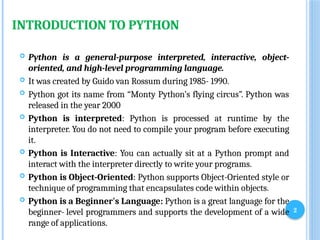
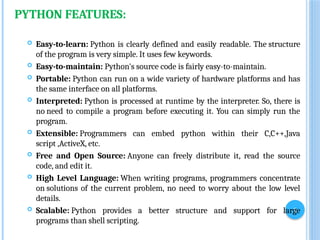

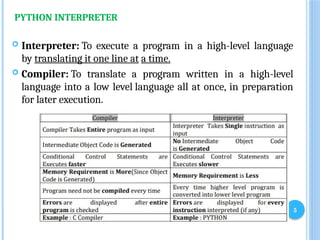






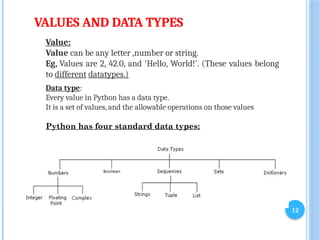
![13
NUMBERS:
• Number data type stores Numerical Values.
• This data type is immutable [i.e. values/items cannot be changed].
• Python supports integers, floating point numbers and complex
numbers. They are defined as](https://image.slidesharecdn.com/2-250619103728-b0cb8ed0/85/Introduction-to-Python-Programming-Language-13-320.jpg)

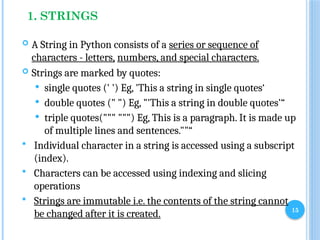
![16
Positive indexing helps in accessing the string from
the beginning.
Negative subscript helps in accessing the string from
the end.
Subscript 0 or –ve n(where n is length of the string)
displays the first element.
Example: A[0] or A[-5] will display “H”
Subscript 1 or –ve (n-1) displays the second element.
Example: A[1] or A[-4] will display “E”](https://image.slidesharecdn.com/2-250619103728-b0cb8ed0/85/Introduction-to-Python-Programming-Language-16-320.jpg)

![18
2. LISTS
List is an ordered
sequence of items.
Values in the list are
called elements /
items.
It can be written as a
list of comma-
separated items
(values)
between square brack
ets[ ].
Items in the lists can
be of different data
types.
Operations on list:
• Indexing
• Slicing
• Concatenation
• Repetitions
• Updation,Insertion,
Deletion](https://image.slidesharecdn.com/2-250619103728-b0cb8ed0/85/Introduction-to-Python-Programming-Language-18-320.jpg)

![20
COND…
Altering the tuple data type leads to error. Following error occurs when
user tries to do.
>>> t[0]="a"
Trace back (most recent call last):
File "<stdin>", line 1, in <module>
Type Error: 'tuple' object does not support item assignment](https://image.slidesharecdn.com/2-250619103728-b0cb8ed0/85/Introduction-to-Python-Programming-Language-20-320.jpg)
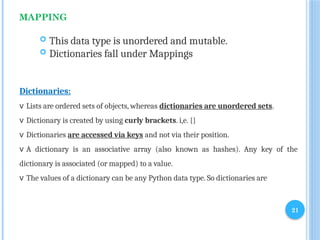
![22
Unordered key-value-pairs (The association of a key and a value is called a key-value
pair )
Dictionaries don't support the sequence operation of the sequence data types like
strings, tuples and lists.
if you try to access a key which doesn't exist, you will get an error message:
>>> words = {"house" : "Haus", "cat":"Katze"}
>>> words["car"]
Traceback (most recent call last):
File "<stdin>", line 1, in <module>
KeyError: 'car'](https://image.slidesharecdn.com/2-250619103728-b0cb8ed0/85/Introduction-to-Python-Programming-Language-22-320.jpg)
![23
Data Type Compile Time Run Time
int a=10 a=int(input(“Enter a “))
float a=10.5 a=float(input(“Enter a “))
char a=“NICHE” a=input(“Enter a string”)
List a=[20,30,40,50] a=list(input(“Enter a list”))
Tuple a=(20,30,40,50) a=tuple(input(“Enter a Tuple”))](https://image.slidesharecdn.com/2-250619103728-b0cb8ed0/85/Introduction-to-Python-Programming-Language-23-320.jpg)








![32
Unpack a Collection
If you have a collection of values in a list, tuple etc. Python
allows you extract the values into variables. This is
called unpacking.
Example
Unpack a list:
fruits = ["apple", "banana", "cherry"]
x, y, z = fruits
print(x)
print(y)
print(z)](https://image.slidesharecdn.com/2-250619103728-b0cb8ed0/85/Introduction-to-Python-Programming-Language-32-320.jpg)






